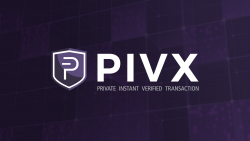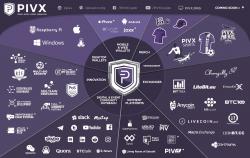In advance of the Bitcoin, Ethereum & Blockchain Superconference in Dallas, Texas (February 16, 17 and 18, 2018), PIVX was asked to be on a podcast with Richard Jacobs of Future Tech Podcasts. PIVX is a Platinum level sponsor of this up and coming conference, and will also be delivering a 30-minute presentation on the main-stage to the thousands of attendees. This marks the second conference PIVX will have attended in 2018 (and a third, Anarchapulco, which PIVX is a gold sponsor of) will also be attended by many Pivians.
Many thanks to Future Tech Podcast for having Snappy on this episode!
You can follow them on Facebook here, Twitter here, and subscribe to future podcasts here!
Here is the audio (and transcript) of the Podcast that Snappy (Bryan) had with Richard this past week.
Audio Player
[Richard Jacobs]:
Hello this is Richard Jacobs with Future Tech podcasts. My guest today is Bryan Doreian. He is part of Community DevelopmenHuge tht and Business Development at PIVX, P-I-V-X. Bryan, how are you?
00:01:22,418 –> 00:01:26,828
[Bryan Doreian]: I’m doing well. Thanks for having me. And on behalf of all of PIVX thanks for having us on.
00:01:26,828 –> 00:01:36,792
[Richard]: Yeah, I’ve heard little snippets about PIVX, but if you can just tell listeners– tell us about the token and the ecosystem. Yeah, what’s the goal of the whole initiative?
00:01:36,792 –> 00:03:38,730
[Bryan]: Yeah, so for those who haven’t heard or don’t know much about PIVX, I’ll give you I guess the sort of the quick history snapshot. A little bit about tech, and then what really matters, I guess, overall. So PIVX is the name. It also is the acronym. It stands for Private Instant Verified Transaction. The coin was announced November 25, 26 of 2015 on Bitcointalk. So back in the good old days when there was no ICO, coins would go on Bitcointalk and basically say, “Hey, here’s what we’re looking to do and planning on doing.” And back then the two co-founders had a vision for a currency that was an actual currency, had a solid economic model, and preserved people’s security and privacy. And was very, very useful with low transaction fees. And we’ll talk about that. So thus private instant verified transaction. It was launched January, 2016. Originally, it was Proof of Work. Again, this was no ICO, no pre-mine, no insta-mine. The coin was launched, mineable, and basically was just developed back in– it’s not that long ago, but in crypto history it’s eons ago, right? So in 2016 unless you were in Bitcointalk you didn’t really know about this project. So it was a lot of active development going on. You can go back through the Bitcointalk thread and see the amount of people contributing, and in the GitHub repos as well. And it just flew under the radar. And then what happened is this: a lot of the community basically came together and said, “Look, we don’t think the name represents who we are.” Right? So when it launched, the name was called DarkNet. Not the best from a PR mass adoption name. I mean, a lot of the coins, if you go back through their history were called several different things before what you currently know them as now, right?
00:03:38,730 –> 00:03:41,830
[Richard]: Yeah, like DASH. Was that DarkCoin?
00:03:41,830 –> 00:05:42,657
[Bryan]: DASH was DarkCoin. Verge I think was DarkDoge [DogecoinDark]. Yeah, so you go back through and there’s been rebrands and rebrands of those coins. Because again, back in the day, developers were basically the leads and the faces of the coins. So kind of a, “Hey we say what goes, right?” The different thing with PIVX is, it is a DAO. It’s a Decentralized Autonomous Organization. So in that the community came together and said, “Hey, we think we want to rebrand the entire project to more accurately reflect who we are, our ethos, and what we do.” So the name was decided upon PIVX. It was voted on by the community. And thus the logo, the purple shield that you see, we are those crazy purple people. If you’ve heard about us, that’s us. And that officially kicked off January 2017 with a large push occurring in March. And from that point on, things just went kind of gangbusters. People were like, “Where did this coin come from? When was it’s ICO?” Etc., etc. We went, “Guys, we’ve been around for a while.” It’s a fair launch coin. There’s no shady stuff going on in the background. It’s just for the first time the community kind of came together and embraced and said, “Hey, let’s do something to reflect who we are as a people.” So some of the tech stuff about it. We are a Bitcoin Core/DASH Core. So with that, though, unlike the majority of what I would say privacy coins that are in the sector – you could lump us in as a privacy coin – we are Proof of Stake. So we’re also the first Proof of Stake coin– PIVX is the first Proof of Stake coin to be above the Bitcoin Core 0.01x. A lot of our code base is already 0.12 which means some of it is at 0.14 already. So from that standpoint, it’s one of the most up-to-date and current Proof of Stake coins actually available.
00:05:42,657 –> 00:06:44,015
[Bryan]: And then from there things just kept developing, right? So with the focus on privacy since again a lot of the code base originally was inherited from DASH, the “privacy” aspect was coin mixing back in the day. But the PIVX developers also did another first. They successfully implemented the Zerocoin Protocol into Proof of Stake. So another first for PIVX was that it is the first Proof of Stake coin to successfully implement Zerocoin. For those of you who don’t know, Zerocoin is an academically vetted protocol that was written by professors and some grad students out of Johns Hopkins. It was originally designed for Bitcoin because they realized, “Hey, Bitcoin’s not private.” So your identity, your ledger transactions are all perfectly traceable. So they said, “Hey, here’s a way to do it and provide complete anonymous transactions.”
00:06:44,015 –> 00:07:01,346
[Richard]: Well, let’s go into that for a second. Let’s go into that for a second. So what makes Bitcoin not private and what makes PIVX private? Can you go into specifics? You threw a lot of names out, but I’m not sure exactly what’s important in the privacy world. I’m not a developer.
00:07:01,346 –> 00:08:58,611
[Bryan]: Yeah, I’m not either. So I just talk to a lot of the developers so I can glean a lot of this up. So I use analogies and I’ll be speaking in Dallas a little bit about this. And one of the analogies I usually say is this: I ask people and I say, “Hey, do you have a checking account, right?” I have a checking account. I presume you have a traditional banking checking account, right? And let’s say that you had a contractor come over and do some work and you wrote a check to them and they went and they cashed it in. Rightfully so. They did work. So you pay them a check. Cash it. They now have money in their checking account. However, what if I told you that that check also allowed them to look at your bank account and see every single deposit in and out since it was first opened? They could see every single record of every in and out. So now that contractor – let’s say it was your plumber – has access to see all of the transactions. Personally for me, that wouldn’t make me too happy. And most people, if they knew that that was going on about their checking account would be up in arms. So that’s the analogy I use and say, “That’s in general what’s going on with the majority of cryptocurrencies today is every time that you spend and send from an address, especially on an exchange, let alone form a core wallet, it gives that user direct access back to every single balance that was ever associated with that address.” So people often say, “Well, what if I create an address every single time?” You can. The thing is, most people do not do that. Some wallets will do it automatically. The other aspect of it is this: the amount of money that’s going into forensics for addresses to track how much money is being sent, how much money is being spent – from where, to where, etc. – is astronomical.
00:08:58,611 –> 00:09:23,759
[Bryan]: So from a privacy standpoint, financially, Bitcoin doesn’t provide that. Litecoin, Ethereum they don’t provide that. PIVX does. So you can basically pay your contractor, you can write them that check, or spend from your PIVX wallet using zPIV which is our Zerocoin PIVX, or Zerocoin PIV, and it completely breaks that link between you and the receiver. So in essence what happens is they get–
00:09:23,759 –> 00:09:26,380
[Richard]: Could you–? Yeah, I was going to ask can you talk about that. How does it happen?
00:09:26,380 –> 00:11:28,162
[Bryan]: Yeah, so in general what happens is you basically are minting in your core wallet. So the core wallet is– so again, I’ll lead into this. So when you download the core wallet, you are running the entire blockchain in PIVX. Because we’re Proof of Stake, right, so we don’t have miners in our ecosystem that are providing the hash power to prove and validate all the transactions. Everyone who has downloaded the core wallet is participating in that. So that’s Proof of Stake. We’re also getting paid for it. So basically in that core wallet, if you have PIV in there you’re staking. You’re earning interest. You also have the ability to mint, it’s called minting a zPIV. And that is the privacy Z. That’s the privacy PIV. So what happens with that is this: you basically go from having PIV, which is the public ledger, you can trace it you can see it – PIVX – which is great for merchants, etc., etc. To now I’ve got a receipt of let’s say I have 100 zPIV. Let’s say I’m going to send that 100 to you. When I elect to hit send to your address, what in essence happens is that receipt is validated in our network, and says, “Yep you have– you can redeem that 100 zPIV.” Basically, that receipt is burned and 100 fresh PIV are created and sent to the recipient, right? So you would then receive 100 PIV that are brand new. There’s no identity. There’s no history associated with them. And the reason you can is because you validated that you have that receipt. It’s a lot more complicated than that, but that’s the easiest way to think about it. So basically you would receive clean, brand new, perfectly minted 100 PIV. So there’s no difference in terms of the– numbers aren’t being changed in terms of the total balance of PIVX in the network, all it’s saying is you basically had 100 zPIV, you had that credited to you, so now you just cashed in that receipt, and then 100 PIV are then sent out and they’re brand new.
00:11:28,162 –> 00:11:32,376
[Richard]: Okay, so what happens to the “old” PIV? Are they destroyed, or–?
00:11:32,376 –> 00:11:56,853
[Bryan]: Yeah, so when you basically– so when you basically are minting it, you are basically removing those from the circulation into your zPIV. In essence they’re removed completely from circulation. So it’s a net neutral swap as it were. There’s a small fee associated with creating the zPIV, but there’s no change in terms of the overall net amount of PIV in the network.
00:11:56,853 –> 00:12:03,824
[Richard]: So it’s like if you paid me 20 bucks, somehow I would take the 20 bucks, destroy it and make a new 20 dollar bill, and I’d be able to give you that.
00:12:03,824 –> 00:12:07,011
-Yep. Yep. Yep. You got it.
[Richard]: -You’d never know that–
00:12:07,011 –> 00:13:01,482
[Bryan]: So the nice thing is– so what PIVX has done is again being the first Proof of Stake ever to ever do this, the developers also added a bunch of more features that allow you to send. So is your coin, as it’s been implemented, and a few other coins– has some restrictions or limitations on how much you can send, how many denominations you can send, right? So for instance if you wanted to send seven coins to somebody, in other coins that have implemented your coin you’d have to three separate transactions. So you’d have to send like one, one, and five because that’s the denominations that they’ve allowed? In PIVX, you can send it all in one transaction. So you can send multiple types of denominations within a single transaction. Again, making it easier, more user-friendly for the average consumer. The average user.
00:13:01,482 –> 00:13:11,380
[Richard]: What happens if someone sends PIVX to you and you don’t spend them for a while. Can you tell that I have a certain amount of PIVX, or if I haven’t reminted stuff what do I do?
00:13:11,380 –> 00:14:39,062
[Bryan]: Yeah, so I mean it’s a public ledger so if things are being sent around just as PIV, or just as Bitcoin, or just as Litecoin, that address anybody can sit there and watch, right? So you can go onto a block explorer right now and look and say, “Hey, let’s see this address. Let’s see what the activity of that address is.” Most people don’t realize that about cryptocurrencies. The old sort of what was pushed out by mainstream media is like, “Oh, Bitcoin’s this private currency used by dark markets, blah, blah, blah, blah, blah.” It’s actually the opposite. It’s a perfect ledger. So if you’ve got Bitcoin sitting in an account, even though you might not have touched it for five years, if somebody has that address, or if somebody who sent it to you has that address, they can see, “Hey, there’s still five Bitcoins sitting in that address.” This is why– yeah, so from an individual, and this ties back into sort of the point of PIVX, from a security standpoint and from a privacy standpoint, a lot of us feel it’s imperative to maintain that privacy as individuals. We say it’s a right from the standpoint of how many times have companies or banks or entities been hacked where there’s personal information that has been leaked, identified and put out into markets and sold, etc? Or, how many times is information “used” by corporations, etc., without your consent? And then, “Oops. Oh, by the way we did do that.”
00:14:39,062 –> 00:15:46,527
[Bryan]: So what PIVX has done is design and develop a mechanism whereby you are free to enact– it’s your choice, but you’re free to maintain that privacy and security within the network, right? And in that network, it’s a network whereas I said it’s Proof of Stake, so you’re in control of it. So since you can download– you have the freedom to download a core wallet and run the entire blockchain. You’re actually participating in maintaining that currency, right? Unlike with mining where most people that hold coins that are mined – that are minable – Proof of Work, like Bitcoin, like Litecoin and Ethereum. Again, there’s nothing wrong with these, it’s just that people don’t realize they aren’t actually in control of the currency itself. Right? So unless you’re mining those currencies, you’re not in control of that blockchain. You’re sort of at the discretionary mercy of the miners themselves. Well, in PIVX, you download the core wallet. You’re running that entire blockchain. You’re actually participating in the validation and confirmation of all the transactions. So if all–
00:15:46,527 –> 00:15:48,219
[Richard]: Wait a minute. I have a quick question here.
00:15:48,219 –> 00:15:49,094
[Bryan]: Yeah. Yeah.
00:15:49,094 –> 00:16:00,185
[Richard]: If you’re Proof of Stake, though, that means you’re holding X number of PIVX in a wallet. How do you obscure that fact? How much do you need to stake PIVX? Let’s say it’s a–
00:16:00,185 –> 00:16:01,022
[Bryan]: -One.
[Richard]: – –thousand or something?
00:16:01,022 –> 00:16:02,875
[Bryan]: -One.
[Richard]: -One? Okay. So it’s very low?
00:16:02,875 –> 00:16:04,813
[Bryan]: -You need– it’s very low. Yep.
[Richard]: -It doesn’t matter if I had a–
00:16:04,813 –> 00:16:12,417
[Richard]: But what about large stakeholders of PIVX, though? What if they want to keep quiet that they have all this PIVX sitting in their wallet and they’re using it to run the network stake?
00:16:12,417 –> 00:17:02,509
[Bryan]: Sure. Good question. So, a couple options. So we talked about ledger privacy, right? So those individuals right now, if they have us in an address, yes, that could be identified. What’s coming in Quarter 1– so the Zerocoin Protocol was successfully implemented in November. So just a few months ago. By the end of Q1 2018, we will have fully stakable zPIV. Meaning you can basically convert all of your PIVX into zPIV and stake those as well. And actually people who do that will earn a higher reward. So that’ll take care of that factor. So basically you could take– let’s say you have 500 PIV or 1000 PIV, you can convert all those into zPIV, put that into an address and nobody will know except for you. So that’s that one. The other app–
00:17:02,509 –> 00:17:08,436
[Richard]: The protocol will know, though? The protocol will know you have 500 let’s say so–
00:17:08,436 –> 00:17:10,599
[Richard]: – –you’re still staying– that’s great.
[Bryan]: -Bingo. Bingo, but anyone–
00:17:10,599 –> 00:18:00,287
[Bryan]: Anyone else but you will not have an ability to know. So then the other aspects about privacy can come into play about hey what about your IP addresses. PIVX already allows– there’s the ability to run behind TOR. So if you want to provide that layer of your IP address privacy. What is coming this year as well is I2P. So there will be an I2P network which as well as a Dandelion Protocol. Those are two separate protocols that will allow the further basically privacy of IP addresses. So not just from a ledger/balance account privacy is, it will also be the personal identification back to say where you’re located, etc. That’ll be completely private as well.
00:18:00,287 –> 00:18:11,711
[Richard]: Interesting. All right. So do you think that the–? Well, I don’t know much about I2P or IPFS. Can you explain that basically? I know TOR obscures your IP address, but what’s the other pieces of the puzzle?
00:18:11,711 –> 00:20:01,125
[Bryan]: Yeah, so with the Dandelion– again, these are questions that are brilliant for developers. The Dandelion Protocol, what I’m aware of of that, is basically you have a stem, kind of like a dandelion. You’ve got a stem and then you’ve got the fluff, right? So there’s these layers that help deanonymize or anonymize your IP from the outside. So it’s this algorithm way to basically say, “Okay, here’s your IP, it’s running through the stem and then out through this other layer.” So even if people crack through that first layer they still have to go through another entire layer before they can track it back to you. The other thing I wanted to touch on about PIVX being a DAO, decentralized autonomous organization if I can is what I said about PIVX being a coin that you can control, right, individually by running the entire blockchain. You also as staking you get paid for that, right? So since we don’t have miners, which in Proof of Work coins the incentivization for a miner to mine is that block reward, right? So in Proof of Stake, since we don’t have miners, that block reward is paid out to the people running the network itself. It’s also split between Masternodes. We do have an entire Masternode network in PIVX. Those are going to be coming up very soon because we will have the first in-wallet decentralized exchange called a zDEX where you’ll be able to exchange Bitcoin, potentially some other coins as well, directly for zPIV. So you’ll have a direct swap for the privacy coin itself. So again that block reward is split between stakers and Masternode holders.
00:20:01,125 –> 00:20:55,923
[Bryan]: The other aspect about being a DAO in a coin that’s community consensus driven is the governance, right? So we have already voted to develop a CDG, which is Community Designed Governance. Currently right now everything Is funded by a self-funded treasury, right? So the block reward up to 10% of every block is available as part of the treasury. So every 30 days anyone, not even anybody that’s “active” in PIVX, can submit a proposal and have it go up for community voting. So currently Masternodes vote on proposals. Soon it will be available for anybody within the PIVX network to vote on. And that’s largely how a lot of the direction of the community operates is by submitting proposals, voting them in, and then monitoring the success of those proposals themselves.
00:20:55,923 –> 00:20:59,587
[Richard]: What’s the requirement for a Masternode? And what benefits do they give?
00:20:59,587 –> 00:21:37,712
[Bryan]: Sure, so currently it’s 10,000 PIVX. Current price it’s about USD$100,000. ROI on a Masternode and ROI on staking is anywhere from 6 to 10 percent a year. And that’s in PIV, mind you, that’s not in US dollars. That’s in quantity of PIV. What will be beneficial to be a Masternode in the future is Masternodes will also begin to share in the profit of running the zDEX, right? So as people begin to exchange Bitcoin, Litecoin, etc., for zPIV there’s going to be a micro-fee. That’ll be shared between Masternodes as well.
00:21:37,712 –> 00:21:39,688
[Richard]: -Hmm. Great.
[Bryan]: -Yep.
00:21:39,688 –> 00:22:08,332
[Bryan]: The other benefit that’ll be available is the PIVX developers, I believe it’s actually Quarter 1 so less than two months. The developers are insane. You’ll be able to put your PIVX collateral, so Masternode collateral that 10,000 PIV onto a Ledger. So you can already store your PIV on a Ledger right now, but you’ll be able to put your 10,000 PIV onto a Ledger, unplug it, throw it into your safe or whatever you want, and still run your Masternode.
00:22:08,332 –> 00:22:11,104
[Richard]: -So you’ll be able to keep your–
[Bryan]: -That’s awesome. So you’ll be able to stake offline?
00:22:11,104 –> 00:22:39,776
[Bryan]: Well, it’s not technically staking. It’s running the Masternode. But you’ll still get your rewards, right? So it’s in essence like staking it’s just for Masternodes at this point. Coming down the road, it’s not currently on the Roadmap, but I know there’s talks about it is to do staking offline as well. So this is the first step towards that. The Masternode holders will be able to keep their initial collateral, which is the bulk of it anyway, right? You’ll be able to keep that offline in cold storage and still be earning your interest, yeah.
00:22:39,776 –> 00:22:48,154
[Richard]: What would be the rights stakeholders that don’t have Masternodes? How diminished would they be compared to a Masternode holder?
00:22:48,154 –> 00:25:01,003
[Bryan]: So actually staking, if you stake when the PIV staking goes active we’re going to call that zPoS because it’s a brand new Proof of Stake protocol. So in ZP if you are staking the zPIV, so it’s zPoS, you’ll actually be getting more rewards than a Masternode will. So every block reward if you’re staking and you are the validator for that block, then you will end up getting three PIV that round and the Masternode will end up getting two. So the other real cool thing too is what we’ve talked a lot about like the privacy aspect. Some of the community governance stuff. Transaction speeds. We have 60-second block times. I mean basically you can send instant sends as well. So zero confirmation sends using the Masternode network as available. Our transaction fees are less than a tenth of a cent right now. So really, really fast. Very, very low fees. The other really neat thing from an economic– again we’re talking about positioning the coin to be used globally and protect privacy. Our inflation rate is about 4% currently. We have a steady 4 1/2, it’s going to be going up to 5 1/2 PIV emission rate every 60 seconds. So that’s the block reward, right? What we also have implemented and this was done and designed form the get go is this; we have what we call a dynamic cap or a soft cap that’s deterministic by use. Since again we’re Proof of Stake, we don’t have to give transaction fees to miners, right, to keep them incentivized to keep mining. So what do we do? In PIVX, we burn them. And what we’ve basically calculated is at about 3 to 4 private transactions a second, we will go coin supply negative meaning more coins will be coming out of circulation than being emitted every 60 seconds. Now we’re not there yet, but we’ve already seen a couple blocks where we had some massive spikes in transactions within the network where I think it was 9 coins were actually burned and only 4 1/2 were created that block. So in that specific block we actually removed coins from circulation.
00:25:01,003 –> 00:25:04,440
[Richard]: Well, what happens though if PIVX starts to just scale–?
00:25:04,440 –> 00:25:05,318
[Bryan]: -Go crazy? Yeah.
[Richard]: – –big time?
00:25:05,318 –> 00:25:09,390
[Richard]: Go to 50 transactions, 1000 a second. What happens then?
00:25:09,390 –> 00:25:37,290
[Bryan]: So the beauty again of having a consensus community is we trust then in one another to say, “Hey, if we want this to be a global currency and useful, well let’s vote, right?” If we’re realizing crap we’re pulling way too many coins out of supply, then we can reduce the transaction fees, right? Or we could basically say we’re going to peg it to a specific inflation rate, or some other design and–
00:25:37,290 –> 00:25:38,734
[Bryan]– –algorithm that, yeah.
[Richard]:-Well why not–?
00:25:38,734 –> 00:25:44,330
[Richard]: Right. Why not algorithmically balance it so that it can never go too negative or too positive as an inflation rate?
00:25:44,330 –> 00:26:25,319
[Bryan]: Bingo. And actually that’s an interesting thought because in Q4 of 2018 the PIVX developers will be implementing elastic blocks to deal with variations and spikes in traffic so that way we can handle ramp ups in number of transactions per second. In theory then, yeah, what you just said as well. Design an algorithm that adapts and says, “Hey, we’re going to keep a steady emission rate, or steady deflationary rate so it doesn’t go crazy.” Yeah. But then again, that’s the beauty of a community voting mechanism to say, “Let’s figure this out.”
00:26:25,319 –> 00:27:03,963
[Richard]: Right. Right. Yeah, I’m sure the nature of the people that are invested in PIVX is– a lot of it is about privacy and I’m concerned about it, too. You said there’s been and I know there’s a ton money and research going to taking the veil off crypto. That it’s not private. And you’re one of the people trying to keep it on. Where is the arms race going? What’s next? What’s going to be required for the tokens that don’t seem to acknowledge or realize that blockchain could be used to the opposite effect to strip away all privacy. What do you think is going to happen? How is this going to evolve? Are we going to have certain tokens that just are completely exposed and will people not use them? Some will remain private? Where do you think this is going?
00:27:03,963 –> 00:28:27,349
[Bryan]: So I see this as a personally a deeper philosophical question. I look around in general at the public and most people freely give over information, whether it’s Facebook or Twitter or Google, etc. They sign up for email lists and nobody reads disclaimers about what’s being tracked, etc. So I think there’s a general public malaise of people feel like, “Hey, if somebody’s not knocking on my door or coming in with a shotgun or etc., then I’m okay.” Right? I think though that there is a tide. There is a shift of a lot more people going, “No this actually does matter,” because for a lot of years maybe even centuries information data has been used by a selective few to control a lot of what’s going on, right? So I think what we can see happen and occur is by focusing on why privacy matters, right? So what tends to happen is privacy’s put down as, “Oh, it’s used in the dark markets.” Right? “It’s used for shady nefarious deals, and that’s why this shouldn’t be allowed.” And of course, I kind of laugh and I go, “Right. So you’re telling me the US dollar, etc., the oil dollar has never been used for shady nefarious deals ever in the history of the world.
00:28:27,349 –> 00:28:28,809
[Bryan] -So, got it.
[Richard]: -Right. Yeah.
00:28:28,809 –> 00:30:39,331
[Bryan]: The deeper issue is you do have a choice, and with PIVX we can begin to empower people by providing incredible tech that maintains privacy and yet the bigger thing for us is the focus is, yes, providing the technology. However, if you begin to look at our marketing. If you look at the branding. If you look at the feel of the coin. It’s designed to feel like we’re here, we will provide insane egregious support, we will tell you about crypto, we’re here to be of use and be resourceful for you. Why? Because if we can be that trusted or one of the trusted communities in crypto that can speak to people and build those relationships. It’s like at the end of the day this is all about relationships, right? I develop relationships with the community. You develop relationships with the community. And then you develop this unspoken trust. We all have these barometers – these trust barometers – that we walk around with, right? Without people, without relationships, blockchain tech is nothing. Right? Without people it’s just another technology. So the issue for me and where the benefit is, is if we can build a relational community that focuses on what matters more. And for us, a lot of what matters most is– yeah, privacy matters. However, with that it’s about being people. About being human. It’s about trusting one another. Developing those relationships. And with that, that means you’ve got to have impactful tech. You’ve got to maintain high integrity. Your developers have to follow through on their word. Your marketing can’t be fluff and for show. It’s just got to present the truth and be accurate. And then the people involved? Let’s respond and resonate together so that new people coming into crypto will go, “Oh, okay. Hey, I’m going to go talk to these people.” Why? “Because I kind of feel like I can trust them.” Then we have an opportunity to say, “Hey, you might not ever understand the tech side of things. That’s okay. Let’s work on trust. Trusting that the developers will actually follow through on what they’re saying they’re going to do. That they’ll build out these protocols to ensure. And then let’s work together as a community to begin to reach other people around us.
00:30:39,331 –> 00:30:48,825
[Richard]: Very good. All right, Bryan. So how do people reach out to you and others involved with PIVX? What’s the best way for them to get in contact with you to find out more?
00:30:48,825 –> 00:32:00,028
[Bryan]: Yeah. So the main website’s www.pivx.org and for those of you who are non-native English speakers I think the website’s currently translated into 32 or 33 native languages. We have an insane translation team. Again, because we were designed to go global. So we’ve put a lot of emphasis on embracing people around the world. So that’s chuck full of information. The majority of the community that you will see and experience in PIVX does hang out on Discord. There are links. So all the social links, whether it be Discord or if you do use Twitter or Facebook, etc., Reddit. Those are all there. Come in. Say hi. Again, I’m fairly active. I’ve chosen to take an active role and kind of be one of the faces of PIVX, so feel free to reach out. You can find me pretty active throughout the community. But yeah, if there’s any questions at all as well technically, the support team – and those links are on www.pivx.org as well – the support team is phenomenal. They’re globally distributed as well. They’ll do anything and everything they can to be of support.
00:32:00,028 –> 00:32:08,938
[Richard]: All right. That’s great. Well, Bryan I appreciate you coming and I look forward to seeing you at the conference. The Bitcoin, Ethereum and Altcoin Superconference. I thank you so much.
00:32:08,938 –> 00:32:11,099
[Bryan]: Gladly. Thanks again. We’ll see you soon.
00:32:11,099 –> 00:32:55,088
[Narrator]: The Bitcoin, Ethereum, and blockchain Superconference is coming to Dallas, Texas February 16, 17, and 18 in 2018. If you know of a better way to get the latest insider knowledge about crypto, to hear directly from the top minds in this field, to interact personally with 800 fellow crypto lovers, HODLers, investors, miners, traders, developers, and founders, then I’d like to hear about it. If you don’t, then you don’t want to miss out. Register today for the Bitcoin, Ethereum, and Blockchain Superconference. Go to bitcoinsuperconference.com and register today as a super early bird to get the lowest rates on tickets and hotel rooms. That’s bitcoinsuperconference.com.
00:32:55,088 –> 00:33:19,087
[Narrator]: You’ve been listening to Almost Here: Round-the-Corner Future Technology podcast with Richard Jacobs. Subscribe to this podcast, post a review, and discover more future technology that have ways to transform out lives for better or worse. Such as Bitcoin, artificial intelligence, 3D printing, blockchain, virtual reality, and more.






